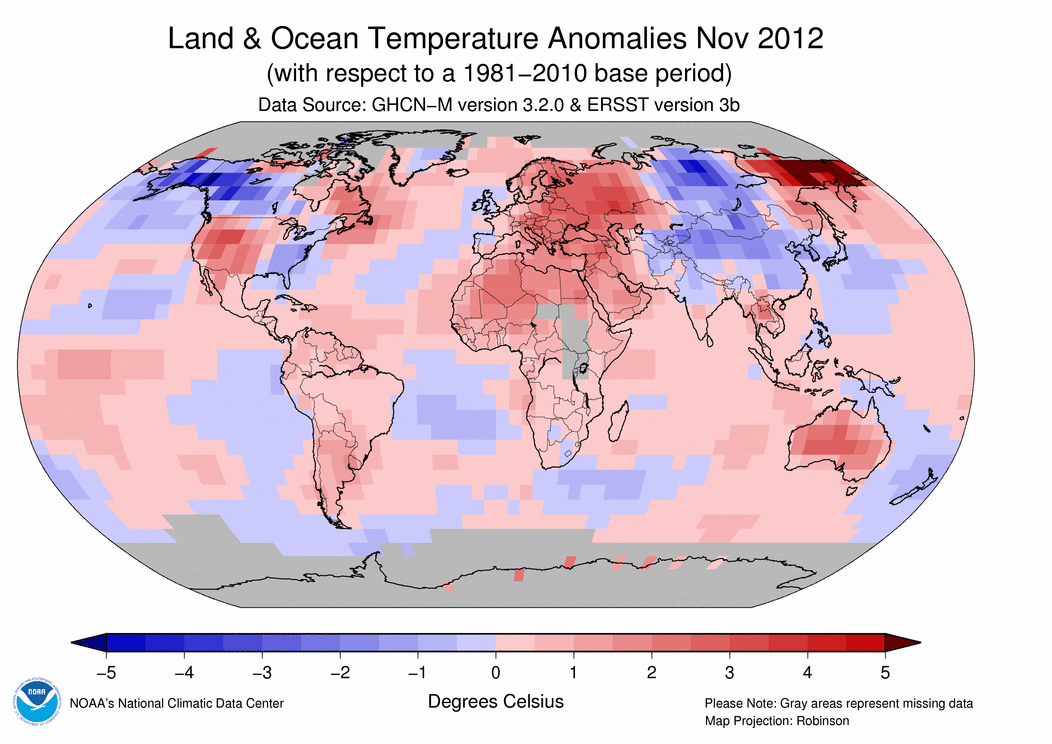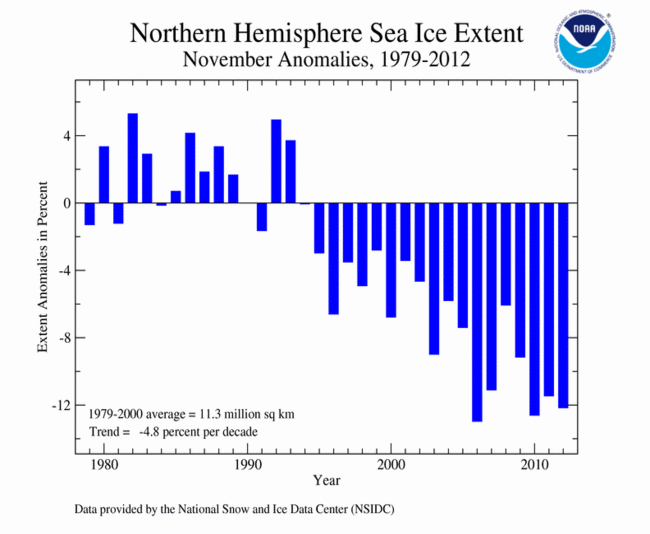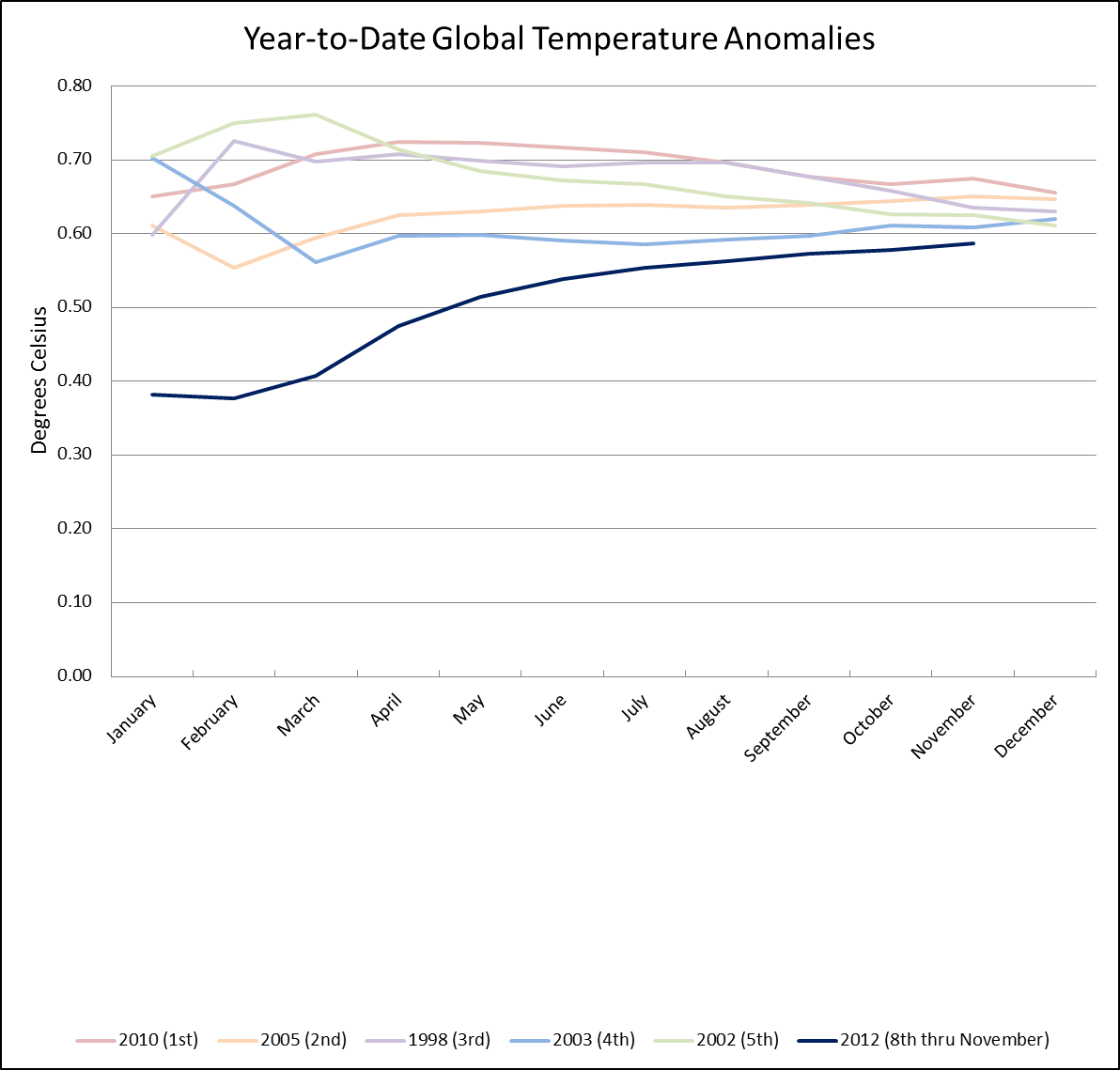Monthly Report Summary Information
The Monthly Report Summary Information is a synopsis of the collection of national and global summaries released each month.
Global Summary Information - November 2012
See Full Report
November 2012 global temperatures were fifth highest on record
The globally-averaged temperature for November 2012 marked the fifth warmest November since record keeping began in 1880. November 2012 also marks the 36th consecutive November and 333rd consecutive month with a global temperature above the 20th century average.
Most areas of the world experienced higher-than-average monthly temperatures, including far eastern Russia, Australia, the central and western United States, northern Africa, and most of Europe and western Asia. Meanwhile, central Asia, Alaska, much of western and central Canada, and the eastern United States were most notably cooler than average.
Global temperature highlights: November
- The combined average temperature over global land and ocean surfaces for November was the fifth highest on record for November, at 56.41°F (13.67°C) or 1.21°F (0.67°C) above the 20th century average. The margin of error associated with this temperature is ±0.13°F (0.07°C).
- November marked the 36th consecutive November and 333rd consecutive month with a global temperature above the 20th century average. The last below-average temperature November was November 1976 and the last below-average temperature month was February 1985.
- The global land temperature was the sixth warmest November on record, at 2.03°F (1.13°C) above the 20th century average. The margin of error is ±0.20°F (0.11°C).
- Some national highlights are included below:
-
- The average November daytime (maximum) temperature across Australia was 3.11°F (1.73°C) above normal, making it the country's fourth warmest November since national records began in 1950. No state or territory had maximum or minimum temperatures below the long-term average.
- The nationally averaged temperature for South Korea was 3.4°F (1.9°C) below average, marking the fifth lowest November maximum temperature since records began in 1973.
- Temperatures ranged from 4.3 to 7.9°F (2.4 to 4.4°C) above average across Croatia during November. Northwestern and eastern Croatia were "very warm" while most of central and southern Croatia were "extremely warm", as categorized by the country's national meteorological service.
- Neutral conditions continued during November across the central and eastern equatorial Pacific Ocean, with sea surface temperatures slightly above average. According to NOAA's Climate Prediction Center, neutral conditions will likely continue through the Northern Hemisphere winter 2012/13 into spring 2013.
Precipitation highlights: November
- Parts of southwest to northeast England saw more than 150 percent of average precipitation, primarily due to a series of low pressure systems that brought heavy rainfall and subsequent flooding to the area within a one-week period.
- Spain was wetter than average during November, receiving 150 percent of average precipitation for the month.
Polar ice highlights: November
- The Northern Hemisphere snow cover extent for November was the fifth largest monthly extent in the 47-year period of record at 889,000 square miles above average. The North American snow cover extent was the 12th largest for November, while the Eurasian snow cover was the eighth largest. Canada and eastern China experienced above-average snow cover, while the United States, eastern Europe, and the Tibetan Plateau had below-average snow cover.
- Arctic sea ice continued to rapidly expand during its annual growth cycle but still remained much smaller than average. The November Arctic sea ice extent was 3.83 million square miles, 12.2 percent below average. This was the third smallest November Arctic sea ice extent on record.
- Antarctic sea ice extent was 6.42 million square miles, 2.4 percent above average, and the sixth largest November Antarctic sea ice extent on record.
Global temperature highlights: September–November
- The combined average temperature over global land and ocean surfaces for September–November was the second highest on record for this period, behind 2005, 1.21°F (0.67°C) above the 20th century average of 57.1°F (14.0°C). The margin of error associated with this temperature is ±0.16°F (0.09°C).
- The global land temperature was the third warmest September–November on record, at 1.85°F (1.03°C) above the 20th century average of 48.3°F (9.1°C). The margin of error is ±0.32°F (0.18°C).
- For the ocean, the September–November global sea surface temperature was 0.95°F (0.53°C) above the 20th century average of 61.5°F (16.4°C), the fourth warmest for September–November on record. The margin of error is ±0.07°F (0.04°C).
Global temperature highlights: Year to Date
- Record to near-record warmth over land from April to September and warmer-than-average global ocean temperatures in the eastern equatorial Pacific Ocean resulted in the first 11 months of 2012 ranking as the eighth warmest such period on record, with a combined global land and ocean average surface temperature of 1.06°F (0.59°C) above the 20th century average of 57.2°F (14.0°C). The margin of error is ±0.16°F (0.09°C).
- The January–November worldwide land surface temperature was 1.73°F (0.96°C) above the 20th century average, marking the fifth warmest such period on record. The margin of error is ±0.36°F (0.20°C).
- The global ocean surface temperature for the year to date was 0.81°F (0.45°C) above average and ranked as the ninth warmest such period on record. The margin of error is ±0.05°F (0.03°C).
 NOAA's National Centers for Environmental Information
NOAA's National Centers for Environmental Information




